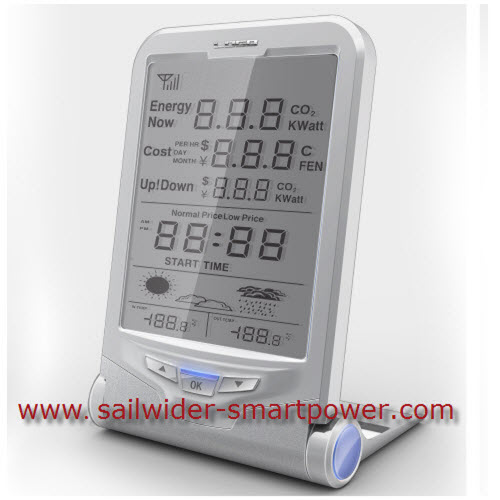A home electricity energy monitor is an easy way to see how much electricity you’re consuming – as you use it – and what it costs. It provides prompt, convenient feedback on electrical energy consumption. Some devices may also display cost of energy used, and estimates of greenhouse CO2 emissions in real time. It is also known as a “real time display”. People who adopt home energy monitors tend to find that their energy usage drops by between 5 percent and 15 percent in the first year of using them. Various studies have shown such a reduction in home energy consumption.
A clip from the monitor is attached to the cable from your electricity meter. The current is then measured and transmitted wirelessly to a monitor with display screen that you can keep anywhere in your house. The display portion is remote from the measurement, communicating with the sensor using a cable, power line communications, or using radio.
The electricity power monitor isn’t a substitute for the electricity bill, but it can provide a good indication of how much your electricity is costing if you update the monitor with any changes to your tariff. A possible means to reduce household energy consumption is to provide real-time feedback to homeowners so they can change their energy using behavior. In small-scale trials of home energy monitors, customers have typically saved 5 – 15 per cent in the first year of owning a monitor.

The Energy Saving Trust estimates that households in the UK waste around eight per cent of their electricity bill on standby power – that’s about £40 a year for an average household. In addition, £170 million a year is wasted through leaving lights on in unused rooms.
Some energy suppliers provide free monitors with selected tariffs; ask your supplier for more information. Otherwise there are a number of retailers selling monitors with different functions.
Generally, a home energy monitor measures energy usage in kilowatt-hours (kWh), and electric companies bill based on kWh used. The kilowatt hour is a measure of power, or watts, multiplied by an amount of time. Using 1,000 watts for one hour is one kilowatt.
Any item in a house that uses energy adds to the overall kilowatt usage of the household. Large appliances can add significant loads to the energy usage of a house, which will drive up total energy costs. A home energy monitor can be used to easily track down devices and appliances that are adding unnecessary kilowatt hours to the overall household energy usage.
An individual home energy monitor can be used between a device and the power outlet to measure the amount of energy that device is using. This is especially helpful for devices which spend time in standby or sleep mode, as the devices can still use a significant amount of energy while plugged in but turned off. Using a home energy monitor that tracks individual device usage can help a homeowner find which devices are better to unplug after use instead of leaving them plugged in and on standby.
There are also home energy monitors which monitor the entire house instead of individual appliances. These are helpful to get a picture of what the real-time energy use of an entire house is. Like the individual energy monitors, these can be used to determine the kWh usage of individual appliances and devices. If everything in the house that uses electricity is turned off, individual appliances can be turned on and the change in energy use can be observed on the whole home energy monitor.
By looking at your smart electricity monitor display, you can see how much electricity your house is using. Over time, you will get used to seeing how little electricity your house needs, and can tell when lights have been left on, or when other appliances have been left on by accident, which may be wasting electricity. You can then turn these energy wasting appliances off, saving you money, reducing your electricity consumption, and helping the environment by reducing your carbon footprint.



